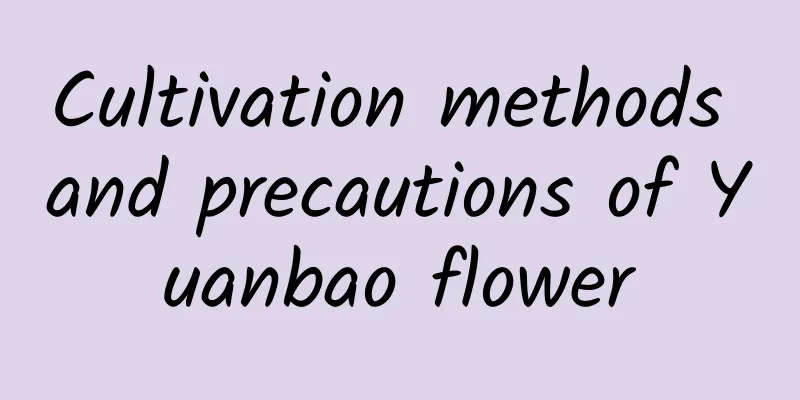Epiphyllum cultivation methods and precautions

|
Epiphyllum belongs to the Cactaceae family and is an epiphytic succulent shrub that can reach a height of 2-6 meters. It likes a warm and humid environment and needs plenty of sunlight, but cannot withstand strong direct light. Epiphyllum usually blooms at night and has a very short flowering period, only about 4 hours from opening to withering. Because of its short flowering period and beautiful flowers, Epiphyllum is particularly precious. Let’s learn about the cultivation methods and precautions of Epiphyllum below. 1. Choose the right potting soil Epiphyllum is not very demanding on soil, and loose, breathable, slightly acidic soil is preferred. You can mix garden soil, leaf mold and river sand in a ratio of 2:2:1 and then plant them, or you can directly use general nutrient soil. This kind of soil is conducive to the growth of the root system of Epiphyllum, making it more luxuriant and increasing the number of new shoots, thus increasing the number of flowers. 2. Arrange lighting properly Epiphyllum likes an environment with sufficient light, but cannot tolerate direct sunlight. In spring, autumn and winter, it should be ensured to receive sufficient light. In summer, it needs appropriate shade, or placed in a bright scattered light environment. Excessive light can easily cause the leaves of Epiphyllum to be sunburned or turn yellow. 3. Proper fertilizer and water management Fertilizer and water management are crucial to the flowering of Epiphyllum. Normally, watering should follow the principle of "water thoroughly when the soil is dry" to avoid excessive watering that may cause root rot. Spring is the season when Epiphyllum grows new buds, so sufficient fertilizer and water should be maintained at this time. It is recommended that in addition to applying slow-release fertilizer , water-soluble growth fertilizer be applied every 15 days or so. This can be done by irrigating the roots or spraying the leaves with water. Adequate fertilizer can make the epiphyllum grow healthily and increase the number of new side shoots. When fertilizing, pay attention to changing fertilizers according to the season and avoid long-term use of a single fertilizer, especially not too much nitrogen fertilizer, otherwise it will easily cause excessive growth and only grow leaves without flowers. After the beginning of summer, the dosage of phosphorus and potassium fertilizers should be increased, and the roots should be irrigated or sprayed with Huaduoduo No. 2 or potassium dihydrogen phosphate fertilizer every 7 days or so. Adequate phosphorus and potassium fertilizers can help the leaves of Epiphyllum mature quickly and produce flower buds. The reason why many flower lovers’ Epiphyllums bloom less or not at all is largely due to insufficient fertilizer and water. 4. Winter management Epiphyllum has poor cold resistance, and the temperature for safe wintering should be above 5℃. If the temperature is below 5℃, it needs to be moved indoors for the winter, otherwise it is prone to frost damage. 5. Pruning and propagation Epiphyllum can grow quite tall. For potted plants, if you need to control the height, you can cut off the top of the new branches. This can not only control the height, but also make the branches stronger. In addition, leaves on branches that are too old or less vigorous can be pruned off to reduce nutrient waste. Branches that grow too vigorously should also be pruned short to control their growth and avoid excessive growth. The pruned branches can be used to propagate seedlings by cuttings. Cut the cuttings into pieces about 10 cm long, insert them into slightly moist soil, and place them in semi-shade to wait for rooting. Epiphyllum cuttings are easy to survive, just be careful not to water too much during the process. In summary, June to September every year is the flowering period of Epiphyllum. If your Epiphyllum has not yet formed flower buds, it is recommended to apply potassium dihydrogen phosphate in time. If the plant has already bloomed once, you can also apply potassium dihydrogen phosphate or Huaduoduo No. 2 to promote the blooming of the second crop of flowers.
|
<<: Geely Red Breeding Methods and Precautions
>>: The breeding methods and precautions of Jinyumantang
Recommend
Can bamboo be planted in a cemetery?
Can bamboo be planted in a cemetery? Bamboo can b...
How to water basil
Tips for watering basil Basil is a plant of the L...
Where is Rehmannia suitable for planting?
Rehmannia glutinosa planting area Generally, Rehm...
How to deal with pruning after the peony flowers have faded (How to care for the peony flowers after they have faded)
Peonies bloom in abundance, symbolizing good luck...
How often should I water the red peperomia?
How often should I water the red peperomia? Gener...
Daisy's growing environment and growing conditions
Daisy Growth Environment and Conditions Daisies w...
How to grow dog tongue grass
1. The habit of this plant First of all, it has a...
Lily growth environment conditions and characteristics
Lily growth environment conditions and requiremen...
Does Cotinus coggygria prefer shade or sun?
Does Cotinus coggygria prefer shade or sun? Cotin...
Bodhi tree cultivation methods and precautions
1. Watering Bodhi trees grow fastest when the tem...
When is the best season to plant okra?
Okra planting season and time The planting time o...
What should I pay attention to when growing lotus? Can it be placed on the indoor balcony?
1. Breeding precautions 1. Ensure sunlight: Sunli...
Illustration of the method of cuttings of baby's breath, how long does it take for the cuttings to bloom
1. Cutting method 1. Prepare the soil: Before sta...
All varieties of Rudbeckia
Rudbeckia - Maya Maya series, plant height 45-50c...
How often should I water cosmos?
How often should I water Cosmos? During the seedl...









